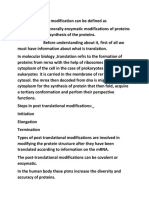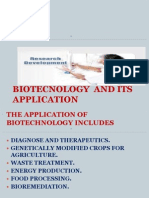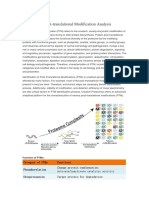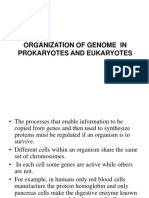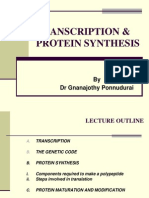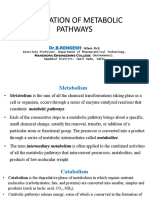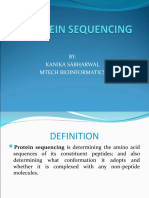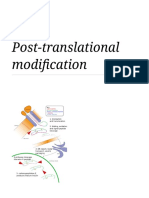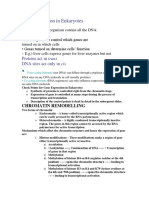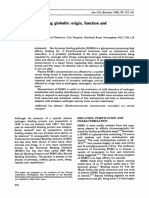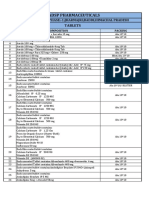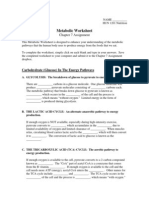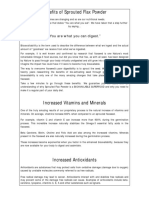0 ratings0% found this document useful (0 votes)
58 viewsTranslation: The Last Stage of Central Dogma
Translation: The Last Stage of Central Dogma
Uploaded by
Chandu Kishore KalloniTranslation is the process by which the information contained in mRNA is used to synthesize proteins. It requires tRNAs, ribosomes, mRNA, amino acids and various enzymes and factors. There are three main steps - initiation, elongation, and termination. Initiation involves the binding of initiation factors, mRNA and fMet-tRNA to form the initiation complex. In elongation, amino acids are added one by one to form the polypeptide chain through the formation of peptide bonds. Termination occurs when a stop codon is reached, causing the release of the complete polypeptide chain.
Copyright:
© All Rights Reserved
Available Formats
Download as PPTX, PDF, TXT or read online from Scribd
Translation: The Last Stage of Central Dogma
Translation: The Last Stage of Central Dogma
Uploaded by
Chandu Kishore Kalloni0 ratings0% found this document useful (0 votes)
58 views10 pagesTranslation is the process by which the information contained in mRNA is used to synthesize proteins. It requires tRNAs, ribosomes, mRNA, amino acids and various enzymes and factors. There are three main steps - initiation, elongation, and termination. Initiation involves the binding of initiation factors, mRNA and fMet-tRNA to form the initiation complex. In elongation, amino acids are added one by one to form the polypeptide chain through the formation of peptide bonds. Termination occurs when a stop codon is reached, causing the release of the complete polypeptide chain.
Original Description:
Process of translation in prokaryotes and eukaryotes
Original Title
Translation
Copyright
© © All Rights Reserved
Available Formats
PPTX, PDF, TXT or read online from Scribd
Share this document
Did you find this document useful?
Is this content inappropriate?
Translation is the process by which the information contained in mRNA is used to synthesize proteins. It requires tRNAs, ribosomes, mRNA, amino acids and various enzymes and factors. There are three main steps - initiation, elongation, and termination. Initiation involves the binding of initiation factors, mRNA and fMet-tRNA to form the initiation complex. In elongation, amino acids are added one by one to form the polypeptide chain through the formation of peptide bonds. Termination occurs when a stop codon is reached, causing the release of the complete polypeptide chain.
Copyright:
© All Rights Reserved
Available Formats
Download as PPTX, PDF, TXT or read online from Scribd
Download as pptx, pdf, or txt
0 ratings0% found this document useful (0 votes)
58 views10 pagesTranslation: The Last Stage of Central Dogma
Translation: The Last Stage of Central Dogma
Uploaded by
Chandu Kishore KalloniTranslation is the process by which the information contained in mRNA is used to synthesize proteins. It requires tRNAs, ribosomes, mRNA, amino acids and various enzymes and factors. There are three main steps - initiation, elongation, and termination. Initiation involves the binding of initiation factors, mRNA and fMet-tRNA to form the initiation complex. In elongation, amino acids are added one by one to form the polypeptide chain through the formation of peptide bonds. Termination occurs when a stop codon is reached, causing the release of the complete polypeptide chain.
Copyright:
© All Rights Reserved
Available Formats
Download as PPTX, PDF, TXT or read online from Scribd
Download as pptx, pdf, or txt
You are on page 1of 10
TRANSLATION
The last stage of central dogma.
Cistron-a unit of DNA or RNA responsible for controlling a
specific body character.
Muton is mutable unit that could be up to five nucleotides long.
Recon is the smallest unit that participates in a recombination
event.
Regulon a group of genes that are coordinately regulated.
Translation
Important components needed for translation
1. Aminoacids
2. Ribosomes- Amino acid site Peptidyl site
3. mRNA
4. tRNA
5. Enzymes
a. Aminoacid activating system( amino acyl tRNA synthetase)
b. Peptide polymerase system
6. ATP for energy source
7. GTP for synthesis of peptide bonds
8 . Initiation and transcription factors
9. Various Inorganic Factors(eg.,K+,Mg+NH+)
Activation of Aminoacid
1. AA+ ATP+ Aminoacyl Synthetase
Aminoacyl Adenylate + Pyrophosphate
2.AA-AMP-ENZYME + tRNA
AA-tRNA + AMP + Enzyme
Translation in Prokaryotes
Initiation: the important change seen in prokaryotes
is in place of methionine , N-Formyl methionine is
the initiator codon in prokaryotes.
Initiation is important step in translation where an
30S pre-initiation complex form with the association
of (mRNA, 30S ribosome, fmet-tRNA, three
proteins called as initiation factors, GTP
Shine Dalgarno sequence: It is an 8 to 13 nucleotide
length an untranslated region of mRNA which
consists of ribosome binding site occurs near to
AUG codon which is also base pairs with 16srRNA
Initiation
1st step: the fmet-tRNA charged with first
aminoacid binds with the 30S ribosome at the P
site
2nd step: fmet-tRNA-30S ribosome binds to 50S
Subunit to form the complete 70S Initiation
Complex.
Energy for this process is provided by Hydrolysis
of GTP brought to initiation complex by IF2
Protein
After initiation two parts of ribosome hold mRNA
in the form ribbon at both side.
Four binding sites are located on the ribosome, one for
mRNA and three for tRNA
The three tRNA sites are labeled P, A, and E
The P site, called the peptidyl site, binds to the tRNA
holding the growing polypeptide chain of amino acids.
The A site (acceptor site), binds to the aminoacyl tRNA,
which holds the new amino acid to be added to the
polypeptide chain. The E site (exit site), serves as a
threshold
Amino acid, any of a group of organic molecules that
consist of a basic amino group (―NH2), an acidic
carboxyl group (―COOH), and an organic R group (or
side chain) that is unique to each amino acid.
Elongation
In this stage second tRNA binds to the ribosome at
the A site with the help of proteins called as
elongation factors.
EF-Tu protein provides proper positioning of
aminoacid which also provides energy for the process
by carrying a molecule of GTP.
Next important step is formation of peptide bond
between two amino acid takes place by replacing first
aminoacid to top second aminoacid
Ensuring bond between carboxyl group of first amino
acid to the amino group of second aminoacid.
The resulting compound is dipeptide reaction is catalysed
by peptidyl transferase enzyme.
The energy for this reaction is provided by dissolution
amino acyl bond between its first amino acid and its
tRNA.
Next step in elongation is translocation which involves.
(a) Ejection of discharged fmet-tRNA from P site
(b) Movement of physical lifting of dipeptide from A site.
(c) movement of mRNA in 5’ to 3’ direction for further
processing.
Termination:
Elongation continues until the ribosome encounters
terminator codons UAA,UGA and UAG.
These terminator codon are recognized by protein
release factors(RF-s),RF1 recognizes UAA and UAG
while RF2 recognizes UGA where as RF3
stimulates both RF1 and RF2
Enzyme peptidyl transferase releases polypeptide
from tRNA which now serve as hydrolysae enzyme
and 70S ribosome dissociate in to two parts 50S and
30S and leave mRNA.
You might also like
- Bio Ch13 l02 QuizDocument3 pagesBio Ch13 l02 Quizghaidaavl443No ratings yet
- Gene Transfer TechniquesDocument36 pagesGene Transfer TechniquesDrMumtaz F MusaliarNo ratings yet
- Purdue Liste PDFDocument2 pagesPurdue Liste PDFSebasNo ratings yet
- 03 Protein StructureDocument5 pages03 Protein StructureIvan TranconNo ratings yet
- Translation in Prokaryotes...... 2.Document13 pagesTranslation in Prokaryotes...... 2.KistoNo ratings yet
- Project Report RsDocument38 pagesProject Report RsVaishnavi PandeyNo ratings yet
- Post Transcriptional ModificationDocument20 pagesPost Transcriptional ModificationZain YaqoobNo ratings yet
- Post-Transcriptional ModificationDocument20 pagesPost-Transcriptional ModificationZain YaqoobNo ratings yet
- Resna N K MicrobiologyDocument54 pagesResna N K MicrobiologyResna N K ResiNo ratings yet
- Gene Expression and RegulationDocument44 pagesGene Expression and RegulationSyama J.S100% (1)
- TranscriptionDocument15 pagesTranscriptiondr.a.k.gupta6924No ratings yet
- Unit 5-Introduction To Biological DatabasesDocument14 pagesUnit 5-Introduction To Biological DatabasesJayakanthan AyyanathanNo ratings yet
- General Translation MechanismDocument15 pagesGeneral Translation MechanismAishwarya KashyapNo ratings yet
- Post Translational ModificationDocument4 pagesPost Translational ModificationSaira DogarNo ratings yet
- Eukaryotic TranscriptionDocument16 pagesEukaryotic TranscriptionKunal DuttaNo ratings yet
- Histone ModificationsDocument8 pagesHistone ModificationsAnna PurnaNo ratings yet
- Eukaryotic TranslationDocument24 pagesEukaryotic Translationtariqul13017No ratings yet
- Biotecnology and Its ApplicationDocument87 pagesBiotecnology and Its ApplicationRangaswamyBiligiraiah100% (1)
- Rna Processing EukaryotesDocument33 pagesRna Processing EukaryotesNathanaelNo ratings yet
- Overview of Post-Translational Modification AnalysisDocument2 pagesOverview of Post-Translational Modification AnalysisSteven4654No ratings yet
- Eukaryote Regulation of Gene ExpressionDocument35 pagesEukaryote Regulation of Gene ExpressiondewiulfaNo ratings yet
- Bacteriophage LambdaDocument118 pagesBacteriophage LambdaKirk SummaTime HenryNo ratings yet
- Ribosomes and Protein SynthesisDocument12 pagesRibosomes and Protein SynthesisSulfeekker AhamedNo ratings yet
- Molecular BiologyDocument9 pagesMolecular Biologyrifat RasheedNo ratings yet
- Organization of Genome in Prokaryotes and EukaryotespptDocument24 pagesOrganization of Genome in Prokaryotes and EukaryotespptRamesh BeniwalNo ratings yet
- Translational Control & Post-Translational ModificationsDocument10 pagesTranslational Control & Post-Translational ModificationsBhaskar GangulyNo ratings yet
- Transcription Protein SynthesisDocument33 pagesTranscription Protein SynthesisSharlene OngNo ratings yet
- Amino Acid, Proteins and Peptide SequencingDocument32 pagesAmino Acid, Proteins and Peptide Sequencingsuu55No ratings yet
- Rna Processing: M.Prasad Naidu MSC Medical Biochemistry, PH.DDocument33 pagesRna Processing: M.Prasad Naidu MSC Medical Biochemistry, PH.DDr. M. Prasad NaiduNo ratings yet
- Biochemistry - Metabolism - Glycolysis & Pentose Phosphate PathwayDocument20 pagesBiochemistry - Metabolism - Glycolysis & Pentose Phosphate PathwayBalakrishnan RengeshNo ratings yet
- BY: Kanika Sabharwal Mtech BioinformaticsDocument21 pagesBY: Kanika Sabharwal Mtech BioinformaticsKanika SabharwalNo ratings yet
- Postranslational ModificationDocument78 pagesPostranslational ModificationnsjunnarkarNo ratings yet
- Post Translational ModificationDocument11 pagesPost Translational ModificationCynCyntya HarlyanaNo ratings yet
- 1.translation 2015Document84 pages1.translation 2015DifaniaNo ratings yet
- Second Messengers Camp CGMPDocument42 pagesSecond Messengers Camp CGMPMirza Shaharyar BaigNo ratings yet
- C Value ParadoxDocument4 pagesC Value ParadoxEr Purushottam PalNo ratings yet
- Unit 2: The Molecular and Biochemical Basis of An OrganismDocument13 pagesUnit 2: The Molecular and Biochemical Basis of An OrganismMeghaNo ratings yet
- Cell Cycle RegulationDocument4 pagesCell Cycle RegulationSomNo ratings yet
- Agrobacterium Mediated Gene Transfer BA3825 SWaghmareDocument8 pagesAgrobacterium Mediated Gene Transfer BA3825 SWaghmareSubash Ragasudha100% (1)
- DNA LigaseDocument5 pagesDNA LigaseBilal Ahmed BarbhuiyaNo ratings yet
- Cholesterol MetabolismDocument38 pagesCholesterol MetabolismAmit KochharNo ratings yet
- RNA Processing or Post Transcriptional Modifications.Document23 pagesRNA Processing or Post Transcriptional Modifications.saeed313bbtNo ratings yet
- Bacterial Genetic RecombinationDocument31 pagesBacterial Genetic Recombinationsharkkzz17No ratings yet
- Transcription & RNA ProcessingDocument36 pagesTranscription & RNA ProcessingSubhajit AdakNo ratings yet
- Dna Ligase, Terminal Transferase, Adapter and LinkerDocument80 pagesDna Ligase, Terminal Transferase, Adapter and LinkerSujit ShandilyaNo ratings yet
- Transcription FactorsDocument13 pagesTranscription Factorsfazila zahoorNo ratings yet
- CRISPR/Cas9 in Zebrafish: An Efficient Combination For Human Genetic Diseases ModelingDocument27 pagesCRISPR/Cas9 in Zebrafish: An Efficient Combination For Human Genetic Diseases ModelingArshia NazirNo ratings yet
- Construction of cDNA LibraryDocument7 pagesConstruction of cDNA LibraryTapasya Changkakati100% (1)
- Regulation of Gene Expression in EuDocument19 pagesRegulation of Gene Expression in EuMohamedNo ratings yet
- Pre-mRNA: 5' Capping Polyadenylation Intron SplicingDocument1 pagePre-mRNA: 5' Capping Polyadenylation Intron SplicingKayoung HeoNo ratings yet
- Post-Translational Modification - WikipediaDocument62 pagesPost-Translational Modification - Wikipediamuskan yadavNo ratings yet
- TranscriptionDocument30 pagesTranscriptionAizelle TarataraNo ratings yet
- Lambda PhageDocument21 pagesLambda PhageMagesh RamasamyNo ratings yet
- Gene Expression 1Document28 pagesGene Expression 1ha88ial88No ratings yet
- Chromatin RemodelingDocument5 pagesChromatin RemodelingRohit GargNo ratings yet
- Virus Induced Gene Silencing (VIGS)Document45 pagesVirus Induced Gene Silencing (VIGS)Praveen Molekar100% (1)
- Regulation of Gene Expression-1Document20 pagesRegulation of Gene Expression-1Iram MalikNo ratings yet
- Gene Expression in ProkaryotesDocument43 pagesGene Expression in ProkaryotesravibiriNo ratings yet
- Post-Translational Modification: Dr. Md. Imtaiyaz HassanDocument61 pagesPost-Translational Modification: Dr. Md. Imtaiyaz Hassanbiotechnology2007100% (1)
- 7.1 Linkage and Crossing OverDocument34 pages7.1 Linkage and Crossing OverDhungana Surya RdNo ratings yet
- Genomes in Prokaryotes and EukaryotesDocument46 pagesGenomes in Prokaryotes and EukaryoteskityamuwesiNo ratings yet
- Histone ModificationsDocument61 pagesHistone ModificationsNitin BagraNo ratings yet
- Processing and Performance Additives For PlasticsDocument13 pagesProcessing and Performance Additives For PlasticsJoselyn GaliciaNo ratings yet
- Essential Organic Chemistry Paula Yurkanis Bruice All Chapter Instant DownloadDocument62 pagesEssential Organic Chemistry Paula Yurkanis Bruice All Chapter Instant Downloadtulacikayap100% (2)
- Loaded1-Prof - DO.Moronkola-CHE-176-2023-Course Content1Document58 pagesLoaded1-Prof - DO.Moronkola-CHE-176-2023-Course Content1taiwodamola789No ratings yet
- MCQS ORGANIC ChemistryDocument6 pagesMCQS ORGANIC Chemistrymalikimran28No ratings yet
- Sex Hormone Binding Globulin: Origin, Function and Clinical SignificanceDocument10 pagesSex Hormone Binding Globulin: Origin, Function and Clinical SignificanceJamesNo ratings yet
- Solvent Based Inks Solvents:: Flexographic Ink For Polyethylene FilmDocument7 pagesSolvent Based Inks Solvents:: Flexographic Ink For Polyethylene Filmfarukh azeemNo ratings yet
- вопросы и ответы английскийDocument109 pagesвопросы и ответы английскийSucces ShabanguNo ratings yet
- Vitamin A - CatsDocument22 pagesVitamin A - CatsPreethi dassanayakeNo ratings yet
- 6.0 Nucleotide Metabolism 2019Document60 pages6.0 Nucleotide Metabolism 2019Emmanuel ChendaNo ratings yet
- CMB MCQs 2011 PDFDocument2 pagesCMB MCQs 2011 PDFjf5014No ratings yet
- Jurnal FE Kelompok 3 PDFDocument10 pagesJurnal FE Kelompok 3 PDFNur Kamilah IdzanNo ratings yet
- Vadsp Human Product List 2021Document31 pagesVadsp Human Product List 2021Nirmal JainNo ratings yet
- Pacop Red Pharmaceutical ChemistryDocument109 pagesPacop Red Pharmaceutical ChemistryAstherielle GalvezNo ratings yet
- Macromolecule LabDocument6 pagesMacromolecule Labapi-271196093No ratings yet
- About EPA and DHADocument7 pagesAbout EPA and DHASha ShaNo ratings yet
- Protection and Deprotection PDFDocument50 pagesProtection and Deprotection PDFKartik RanaNo ratings yet
- Construction and Building Materials: Nazia Tarannum, Km. Pooja, Rizwan KhanDocument15 pagesConstruction and Building Materials: Nazia Tarannum, Km. Pooja, Rizwan KhanClaudia CarhuaniNo ratings yet
- Biochemistry - Chapter 17 Dr. Bongon: Glycolysis & Oxidation of PyruvateDocument6 pagesBiochemistry - Chapter 17 Dr. Bongon: Glycolysis & Oxidation of PyruvateChaze WaldenNo ratings yet
- Pharmacognosy GelatinDocument1 pagePharmacognosy Gelatinparthdd04No ratings yet
- Dr. Mohamed Khomsi Protein Chemistry (2023)Document47 pagesDr. Mohamed Khomsi Protein Chemistry (2023)kasem.gaaimmNo ratings yet
- Metabolic WorksheetDocument3 pagesMetabolic Worksheetjamaica46No ratings yet
- Bruck Oncology Product ListDocument8 pagesBruck Oncology Product Listsanjay_gawaliNo ratings yet
- Detail Sertifikat TKDN Obat ObatanDocument116 pagesDetail Sertifikat TKDN Obat Obatannakes puskesmas Kecamatan Cempaka PutihNo ratings yet
- RSC PET ReviewDocument26 pagesRSC PET Reviewbitisa5368No ratings yet
- Obat KadaluarsaDocument9 pagesObat KadaluarsaParnart ChristineNo ratings yet
- Flaxbenefits - Germinado de LinazaDocument4 pagesFlaxbenefits - Germinado de LinazamarmotaxxNo ratings yet
- AHFS CategoriesDocument12 pagesAHFS CategoriesEidetikosNo ratings yet













